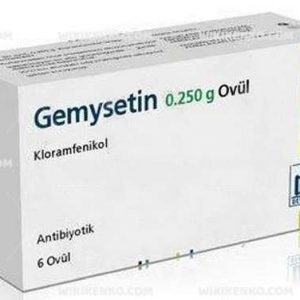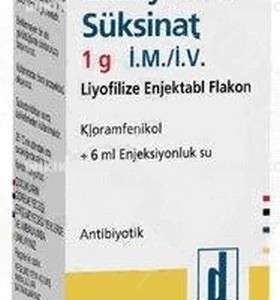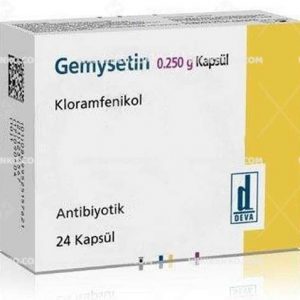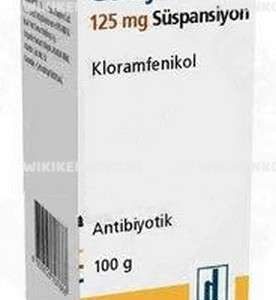Gemysetin Oftalmik Pomat
Gemysetin Oftalmik Pomat is a medication used to treat superficial ocular infections caused by organisms sensitive to chloramphenicol. It is important to use this medication with caution and follow the precautions listed to avoid any potential side effects. If you experience any side effects, speak with your doctor for guidance on how to manage them.
| Manufacturer | |
|---|---|
| Origin | |
| Generic Name (Ingredient) | Active Substance: Each Tube Contains 0.05 G Chloramphenicol Micronized. |
Assuming your emergency circumstances for this product, visit Urgent Quotation page. Besides, for any pharmaceutical questions, please ask us in the comments section.
Description
Usage
Gemysetin Oftalmik Pomat belongs to a group of drugs called Duyu Organları, Oftalmolojik İlaçlar, Antienfektifler, Antibiyotikler, Kloramfenikol-oftalmik, and is indicated for the treatment of superficial ocular infections occurring in the cornea or conjunctiva caused by organisms sensitive to chloramphenicol. It is a slippery yellow ointment that comes in a cardboard box containing 5g of ophthalmic ointment.
Precautions
Before using Gemysetin Oftalmik Pomat, it is important to take note of the following precautions:
Allergies – Do not use this medication if you are allergic to chloramphenicol or any of its other ingredients. It is essential to check the list of ingredients before using the medication.
Blood disorders – If you or your family have a history of blood dyscrasia, including aplastic anemia, avoid using this medication. Aplastic anemia is a severe decrease in the number of blood cells.
Existing eye conditions – Use Gemysetin Oftalmik Pomat with caution if you have severe pain inside your eye, vision problems, discomfort or pain from light or brightness, unusual pupil appearance, blurred vision, swelling or pain around your eye or face, had conjunctivitis in the past month, high intraocular pressure, dry eye syndrome, eye injury, suspicion of a foreign body in your eye, currently using eye ointments or eye drops, or had eye surgery or laser treatment in the past 6 months.
Contact lenses – If you wear contact lenses, consult your doctor before starting to use this medication. During treatment and for 24 hours after completing the treatment, do not wear your contact lenses.
Side Effects
While using Gemysetin Oftalmik Pomat, you may experience side effects. The most severe side effect is bone marrow depression. Serious and fatal blood dyscrasias, including aplastic anemia, hypoplastic anemia, thrombocytopenia, and granulocytopenia, are known to occur after the administration of Gemysetin. Other side effects may include diarrhea, enterocolitis, gray syndrome, headache, nausea, nightmares, and inflammation of the optic nerve.
It is important to note that not everyone experiences side effects. The severity and duration of side effects may vary from person to person. If you experience any side effects while using Gemysetin Oftalmik Pomat, speak with your doctor. They will be able to provide you with more information and advice on how to manage any side effects you may be experiencing.
Conclusion
Gemysetin Oftalmik Pomat is a medication containing chloramphenicol, used for the treatment of superficial ocular infections. While it can be an effective treatment, it is important to use this medication cautiously and only under the guidance of a healthcare professional. The potential side effects, including bone marrow depression and blood dyscrasias, should be taken seriously and promptly reported to a doctor. If used properly, Gemysetin Oftalmik Pomat can help alleviate the symptoms of certain eye infections and promote healing.
Use the form below to report an error
Please answer the questions as thoroughly and accurately as possible. Your answers will help us better understand what kind of mistakes happen, why and where they happen, and in the end the purpose is to build a better archive to guide researchers and professionals around the world.
The information on this page is not intended to be a substitute for professional medical advice, diagnosis, or treatment. always seek the advice for your physician or another qualified health provider with any questions you may have regarding a medical condition. Always remember to
- Ask your own doctor for medical advice.
- Names, brands, and dosage may differ between countries.
- When not feeling well, or experiencing side effects always contact your own doctor.
Cyberchondria
The truth is that when we’re sick, or worried about getting sick, the internet won’t help.
According to Wikipedia, cyberchondria is a mental disorder consisting in the desire to independently make a diagnosis based on the symptoms of diseases described on Internet sites.
Why you can't look for symptoms on the Internet
If diagnoses could be made simply from a textbook or an article on a website, we would all be doctors and treat ourselves. Nothing can replace the experience and knowledge of specially trained people. As in any field, in medicine there are unscrupulous specialists, differences of opinion, inaccurate diagnoses and incorrect test results.







Reviews
There are no reviews yet.